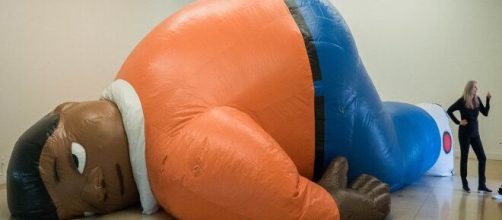Have you ever felt bowled over by the built environment – not only by the racket of construction but also by the enormity of its size?
Size matters
I ask this because the monumental size of contemporary sculpture strikes me like a match in the powder barrel - an overload, even an affront.
I’m thinking of Sculptor Sanford Biggers’ 15,280-pound bronze work titled the Oracle on exhibit in Rockefeller Center through June 29. Twenty-five feet tall, it towers over everything in sight, like Claes Oldenburg’s 45-foot-tall Clothespin over Market Street in Philadelphia.
The look of Biggers’ work is crushing. What’s the point of such bigness?
Reasons why
At least Oldenburg’s Clothespin suggests something human such as an embracing couple. Meaning can also be found in the lopsided sizes of Gulliver and the Lilliputians in Jonathan Swift’s novel. The disparity is a satire on the kingdom of Great Britain. I can even rationalize the monstrous 11-foot-tall Olmec head in ancient Mexico. The outsized face inspires awe.
Overlong explanation
What’s Biggers’ excuse? He told ArtNet News that he wanted to complement Rockefeller Center’s long-standing mythological-themed artwork, like Paul Manship’s statue of Prometheus that looms over the skating rink or the giant Atlas that stares down Fifth Avenue.
Biggers said that besides tying Oracle to the other mythological allusions at the site, his statue completes the story because it bears “a lot of African elements.”
White lie
As he told ArtNet News, he felt free to remix classical sculpture owing to the fact that “contemporary understanding of these forms is already so flawed.” He pointed out that ancient Greek and Roman sculpture is displayed as white marble works even though they were originally highly coloured.
He compares that bright palette to the pigments decorating the masks of Africa. “Editing, cutting and pasting, chopping and screwing has been happening the entire time.”
Big ask
Interesting. But will passersby get all that he says by looking at Oracle? Will they see the link Biggers sought between African masks and Europe’s ancient gods?
Won’t his audience need a libretto to appreciate his work?
But wait, exhibit visitors can ask the Oracle questions, Biggers says. This recalls Zoltan Speaks, the fortune-telling machine in the 1988 movie “Big” in which Tom Hanks played a boy who wishes to be big, and Zoltan grants him his wish. Unlike Oracle, however, Zoltan was not immense.
Small world
Monstrous size didn’t faze The Smithsonian Magazine, which considers the Oracle simply as a “person or deity with an enormous head” who sits “majestically on a throne.” Maybe. But after doing this story, all I want to do is look at Joseph Cornell’s small private worlds of found objects like Victorian bric-a-brac in glass-fronted boxes.
Even though Cornell’s boxes contain discarded items, they have the look of precious items and nostalgic, intimate air. Making precious the remnants of once beautiful objects was his point. And you don’t need an explanation of what you see. His work pulls you in. Oversized work like Biggers’ just doesn’t.


